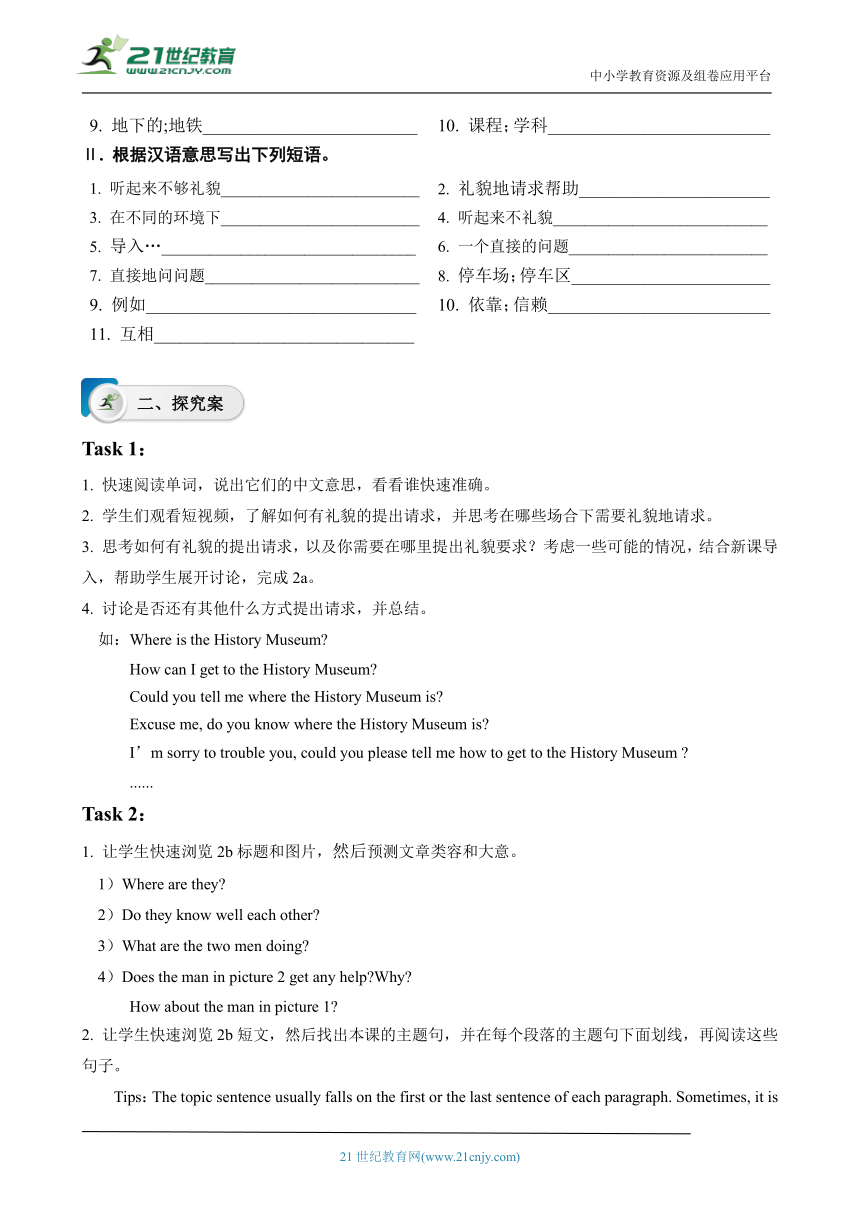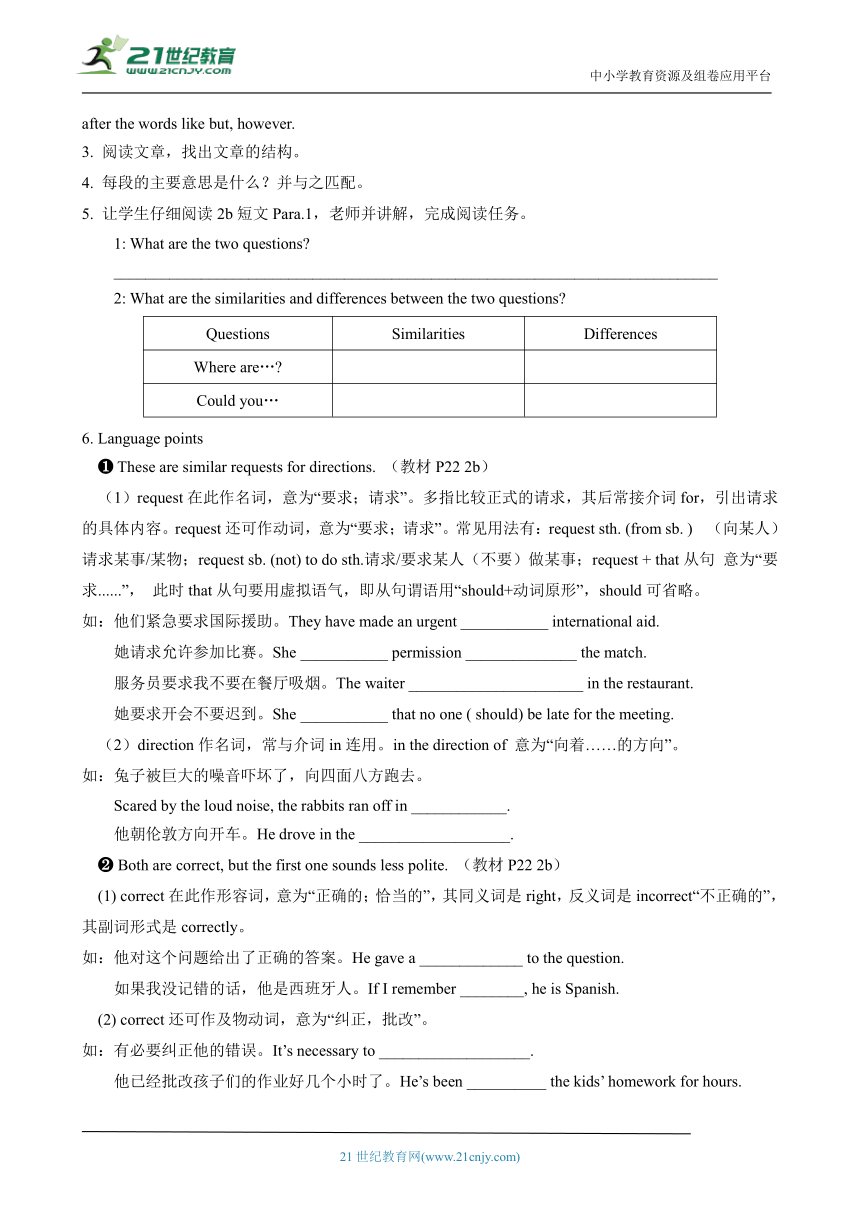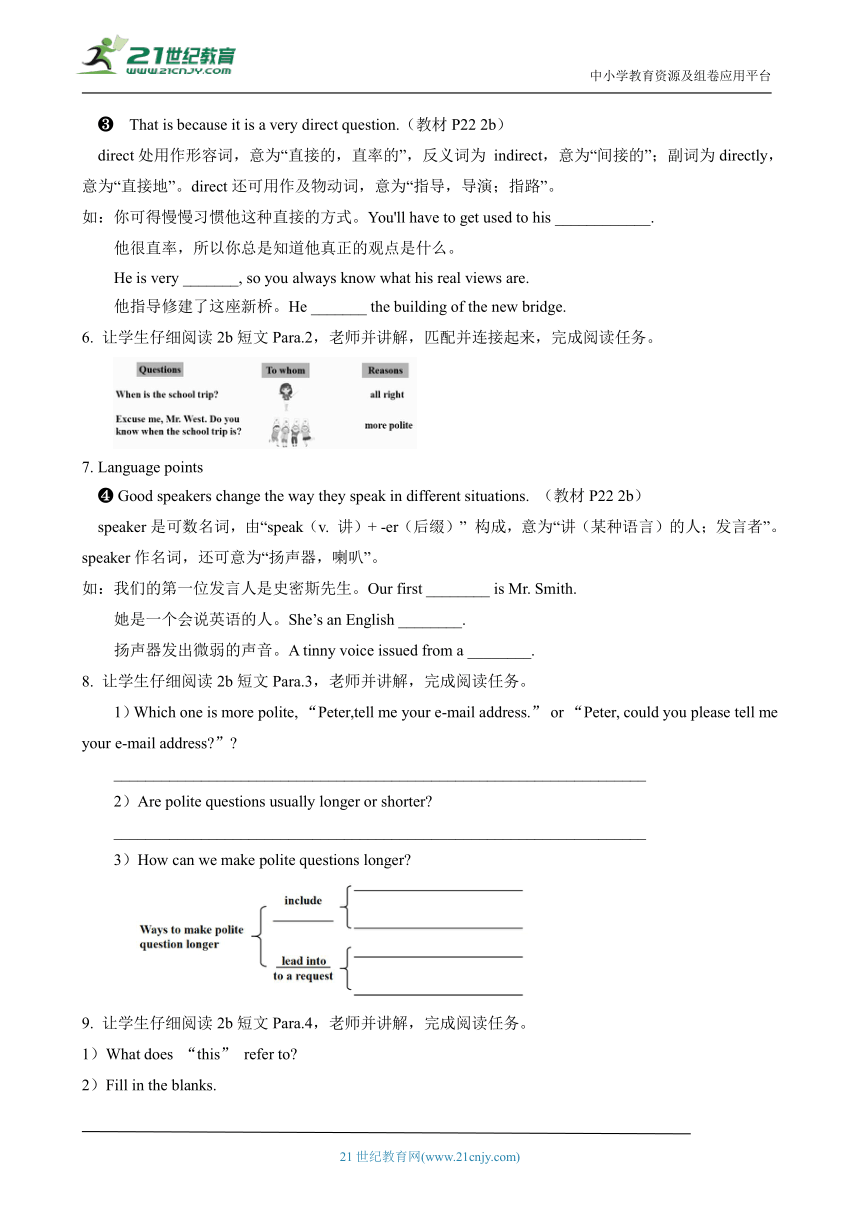【核心素养目标】Unit 3 Could you please tell me where the restrooms are Section B 2a-2d 导学案(含答案)
文档属性
| 名称 | 【核心素养目标】Unit 3 Could you please tell me where the restrooms are Section B 2a-2d 导学案(含答案) |

|
|
| 格式 | docx | ||
| 文件大小 | 1.4MB | ||
| 资源类型 | 试卷 | ||
| 版本资源 | 人教新目标(Go for it)版 | ||
| 科目 | 英语 | ||
| 更新时间 | 2022-09-25 13:45:25 | ||
图片预览




文档简介
中小学教育资源及组卷应用平台
Unit 3 Could you please tell me where the restrooms are
Section B (2a—2d) 导学案
学生姓名 班级 序号 1-5
课题内容 Section B (2a—2d)(阅读课)
学习目标 与 核心素养 Knowledge objectives: 1. 熟练掌握以下词汇和短语 politely, request, direction, correct, polite, whom, impolite, underground, parking lot, address, ask for, for example, depend on, each other, such as, the way to. 2. 熟练掌握以下句型 1. Sometimes we even need to spend time leading into a request. 2. However,it is important to learn how to use the right languages in different situations. 3. It might seem more difficult to speak politely than to be direct. Skill objectives: 1. 观看短视频了解如何有礼貌的提出要求,并思考在哪些场合下需要礼貌地请求。 2. 运用skimming略读策略,学会在不同场合请求帮助时礼貌地请求,并掌握文体结构。 3. 运用scanning查读策略,把握文章细节,能懂得当我们需要被人帮助的时候,要懂得如何向别人提出礼貌的请求,灵活使用阅读技巧,培养阅读能力。 4. 通过听音跟读,纠正发音,并根据思维导图复述课文。 Emotional objectives: 通过阅读文章,培养学生礼貌待人,乐于助人的优良品质。 Thinking quality objectives: 通过阅读文章,思考礼貌地请求与直接请求有什么好处与不同之处。
学习重点 掌握重点单词的词义、词性、发音、固定搭配等。 通过阅读文章,学会阅读技巧,排除阅读障碍,学会礼貌待人,乐于助人的品质。
学习难点
Ⅰ. 根据汉语意思写出下列单词。
礼貌地;客气地__________________________ 方向;方位______________________________
要求;请求______________________________ 正确的;恰当的__________________________
有礼貌的;客气的________________________ 不礼貌的______________________________
直接的;直率的__________________________ 住址;地址;通讯处________________________
地下的;地铁___________________________ 课程;学科____________________________
Ⅱ. 根据汉语意思写出下列短语。
听起来不够礼貌_________________________ 礼貌地请求帮助________________________
在不同的环境下_________________________ 听起来不礼貌___________________________
导入…________________________________ 一个直接的问题_________________________
直接地问问题___________________________ 停车场;停车区_________________________
例如__________________________________ 依靠;信赖____________________________
互相______________________________
Task 1:
1. 快速阅读单词,说出它们的中文意思,看看谁快速准确。
2. 学生们观看短视频,了解如何有礼貌的提出请求,并思考在哪些场合下需要礼貌地请求。
3. 思考如何有礼貌的提出请求,以及你需要在哪里提出礼貌要求?考虑一些可能的情况,结合新课导入,帮助学生展开讨论,完成2a。
4. 讨论是否还有其他什么方式提出请求,并总结。
如:Where is the History Museum
How can I get to the History Museum
Could you tell me where the History Museum is
Excuse me, do you know where the History Museum is
I’m sorry to trouble you, could you please tell me how to get to the History Museum
......
Task 2:
1. 让学生快速浏览2b标题和图片,然后预测文章类容和大意。
1)Where are they
2)Do they know well each other
3)What are the two men doing
4)Does the man in picture 2 get any help Why
How about the man in picture 1
2. 让学生快速浏览2b短文,然后找出本课的主题句,并在每个段落的主题句下面划线,再阅读这些句子。
Tips:The topic sentence usually falls on the first or the last sentence of each paragraph. Sometimes, it is after the words like but, however.
3. 阅读文章,找出文章的结构。
4. 每段的主要意思是什么?并与之匹配。
5. 让学生仔细阅读2b短文Para.1,老师并讲解,完成阅读任务。
1: What are the two questions
____________________________________________________________________________
2: What are the similarities and differences between the two questions
Questions Similarities Differences
Where are…
Could you…
6. Language points
These are similar requests for directions. (教材P22 2b)
(1)request在此作名词,意为“要求;请求”。多指比较正式的请求,其后常接介词for,引出请求的具体内容。request还可作动词,意为“要求;请求”。常见用法有:request sth. (from sb. ) (向某人)请求某事/某物;request sb. (not) to do sth.请求/要求某人(不要)做某事;request + that从句 意为“要求......”, 此时that从句要用虚拟语气,即从句谓语用“should+动词原形”,should可省略。
如:他们紧急要求国际援助。They have made an urgent ___________ international aid.
她请求允许参加比赛。She ___________ permission ______________ the match.
服务员要求我不要在餐厅吸烟。The waiter ______________________ in the restaurant.
她要求开会不要迟到。She ___________ that no one ( should) be late for the meeting.
(2)direction作名词,常与介词in连用。in the direction of 意为“向着……的方向”。
如:兔子被巨大的噪音吓坏了,向四面八方跑去。
Scared by the loud noise, the rabbits ran off in ____________.
他朝伦敦方向开车。He drove in the ___________________.
Both are correct, but the first one sounds less polite. (教材P22 2b)
(1) correct在此作形容词,意为“正确的;恰当的”,其同义词是right,反义词是incorrect“不正确的”,其副词形式是correctly。
如:他对这个问题给出了正确的答案。He gave a _____________ to the question.
如果我没记错的话,他是西班牙人。If I remember ________, he is Spanish.
(2) correct还可作及物动词,意为“纠正,批改”。
如:有必要纠正他的错误。It’s necessary to ___________________.
他已经批改孩子们的作业好几个小时了。He’s been __________ the kids’ homework for hours.
That is because it is a very direct question.(教材P22 2b)
direct处用作形容词,意为“直接的,直率的”,反义词为 indirect,意为“间接的”;副词为directly,意为“直接地”。direct还可用作及物动词,意为“指导,导演;指路”。
如:你可得慢慢习惯他这种直接的方式。You'll have to get used to his ____________.
他很直率,所以你总是知道他真正的观点是什么。
He is very _______, so you always know what his real views are.
他指导修建了这座新桥。He _______ the building of the new bridge.
6. 让学生仔细阅读2b短文Para.2,老师并讲解,匹配并连接起来,完成阅读任务。
7. Language points
Good speakers change the way they speak in different situations. (教材P22 2b)
speaker是可数名词,由“speak(v. 讲)+ -er(后缀)” 构成,意为“讲(某种语言)的人;发言者”。speaker作名词,还可意为“扬声器,喇叭”。
如:我们的第一位发言人是史密斯先生。Our first ________ is Mr. Smith.
她是一个会说英语的人。She’s an English ________.
扬声器发出微弱的声音。A tinny voice issued from a ________.
8. 让学生仔细阅读2b短文Para.3,老师并讲解,完成阅读任务。
1)Which one is more polite, “Peter,tell me your e-mail address.” or “Peter, could you please tell me your e-mail address ”
___________________________________________________________________
2)Are polite questions usually longer or shorter
___________________________________________________________________
3)How can we make polite questions longer
9. 让学生仔细阅读2b短文Para.4,老师并讲解,完成阅读任务。
1)What does “this” refer to
2)Fill in the blanks.
_________ speaking politely might seem more diffucult than speaking directly, it is important to learn how to use the right language in different situations. Because it will be ______ for you to communicate better with other people.
10. 听2b课文,注意重点句段,反复跟读,模仿语音语调,尝试根据思维导图复述课文。
11. 让学生再读该文段以完成2c表格。
12. 学生完成本节2d表格。
Task 3:
1. homework
1) Do the exercises in students’ book.
2) Read and recite in Section B (2b).
3) Preview (Section B 3a-selfcheck).
Ⅰ. 根据句意及汉语提示完成单词。
We can't use the direct ______________(请求) when we ask our teacher for help.
Do you think his answer is ______________(正确的)
I don't know how to get to his home because I have forgotten his ______________(地址).
There is a big ______________(地下的) supermarket near here and you can buy some food in it.
We all like the children who are ______________(有礼貌的).
Ⅱ. 从方框中选词并用其正确形式填空。
direct lead trouble order park wonder lend
This is a busy street. Cars aren't allowed __________ here.
You can choose this plane. It's a(n) __________ flight.
The __________ has come and we have to finish the work in three hours.
Many of us __________ if he could come to the party.
Mr. Wang needs to spend some time __________ into a question.
I don't want to __________ you with such a small problem.
Don't worry about your broken bike.She has__________ hers to you.
Ⅲ. 单项选择。
—Why don't you like that boy
—Because he is ________.
A. polite B. impolite C. politely D. not rude
To ________ is she writing
A. what B. who C. whom D. whose
Do you know ________?
A. when is the basketball game B. when do you have English and math
C. what time is the basketball game D. when the soccer game is
I wonder ________ tonight.
A. where stay B. where to stay C. what stay D. what to stay
—________?
—Sorry, I don't know.
A. What did he happen B. What did happen to him
C. What happened to him D. He happened what
Ⅳ. 句型转换。
To finish so much homework is difficult for him. (改为同义句)
________ ________ difficult for him to finish so much homework.
I don't know. Who(m) is he speaking to (合并为含有宾语从句的复合句)
I don't know ________ ________ ________ speaking to.
It took him three hours to clean the restroom. (用spend改写句子)
He ________ three hours ________ the restroom.
Can you help me I wonder. (合并为含有宾语从句的复合句)
I wonder ________ you ________ help me.
Do you know where I can park my car (改为简单句)
Do you know ________ ________ ________ my car
训练案答案
Ⅰ. 根据句意及汉语提示完成单词。
request correct address underground polite
Ⅱ. 从方框中选词并用其正确形式填空。
to park direct order wondered leading trouble lent
Ⅲ. 单项选择。
B C D B C
Ⅳ. 句型转换。
It is who(m) he is spent; cleaning
if/whether; can where to park
21世纪教育网 www.21cnjy.com 精品试卷·第 2 页 (共 2 页)
21世纪教育网(www.21cnjy.com)
Unit 3 Could you please tell me where the restrooms are
Section B (2a—2d) 导学案
学生姓名 班级 序号 1-5
课题内容 Section B (2a—2d)(阅读课)
学习目标 与 核心素养 Knowledge objectives: 1. 熟练掌握以下词汇和短语 politely, request, direction, correct, polite, whom, impolite, underground, parking lot, address, ask for, for example, depend on, each other, such as, the way to. 2. 熟练掌握以下句型 1. Sometimes we even need to spend time leading into a request. 2. However,it is important to learn how to use the right languages in different situations. 3. It might seem more difficult to speak politely than to be direct. Skill objectives: 1. 观看短视频了解如何有礼貌的提出要求,并思考在哪些场合下需要礼貌地请求。 2. 运用skimming略读策略,学会在不同场合请求帮助时礼貌地请求,并掌握文体结构。 3. 运用scanning查读策略,把握文章细节,能懂得当我们需要被人帮助的时候,要懂得如何向别人提出礼貌的请求,灵活使用阅读技巧,培养阅读能力。 4. 通过听音跟读,纠正发音,并根据思维导图复述课文。 Emotional objectives: 通过阅读文章,培养学生礼貌待人,乐于助人的优良品质。 Thinking quality objectives: 通过阅读文章,思考礼貌地请求与直接请求有什么好处与不同之处。
学习重点 掌握重点单词的词义、词性、发音、固定搭配等。 通过阅读文章,学会阅读技巧,排除阅读障碍,学会礼貌待人,乐于助人的品质。
学习难点
Ⅰ. 根据汉语意思写出下列单词。
礼貌地;客气地__________________________ 方向;方位______________________________
要求;请求______________________________ 正确的;恰当的__________________________
有礼貌的;客气的________________________ 不礼貌的______________________________
直接的;直率的__________________________ 住址;地址;通讯处________________________
地下的;地铁___________________________ 课程;学科____________________________
Ⅱ. 根据汉语意思写出下列短语。
听起来不够礼貌_________________________ 礼貌地请求帮助________________________
在不同的环境下_________________________ 听起来不礼貌___________________________
导入…________________________________ 一个直接的问题_________________________
直接地问问题___________________________ 停车场;停车区_________________________
例如__________________________________ 依靠;信赖____________________________
互相______________________________
Task 1:
1. 快速阅读单词,说出它们的中文意思,看看谁快速准确。
2. 学生们观看短视频,了解如何有礼貌的提出请求,并思考在哪些场合下需要礼貌地请求。
3. 思考如何有礼貌的提出请求,以及你需要在哪里提出礼貌要求?考虑一些可能的情况,结合新课导入,帮助学生展开讨论,完成2a。
4. 讨论是否还有其他什么方式提出请求,并总结。
如:Where is the History Museum
How can I get to the History Museum
Could you tell me where the History Museum is
Excuse me, do you know where the History Museum is
I’m sorry to trouble you, could you please tell me how to get to the History Museum
......
Task 2:
1. 让学生快速浏览2b标题和图片,然后预测文章类容和大意。
1)Where are they
2)Do they know well each other
3)What are the two men doing
4)Does the man in picture 2 get any help Why
How about the man in picture 1
2. 让学生快速浏览2b短文,然后找出本课的主题句,并在每个段落的主题句下面划线,再阅读这些句子。
Tips:The topic sentence usually falls on the first or the last sentence of each paragraph. Sometimes, it is after the words like but, however.
3. 阅读文章,找出文章的结构。
4. 每段的主要意思是什么?并与之匹配。
5. 让学生仔细阅读2b短文Para.1,老师并讲解,完成阅读任务。
1: What are the two questions
____________________________________________________________________________
2: What are the similarities and differences between the two questions
Questions Similarities Differences
Where are…
Could you…
6. Language points
These are similar requests for directions. (教材P22 2b)
(1)request在此作名词,意为“要求;请求”。多指比较正式的请求,其后常接介词for,引出请求的具体内容。request还可作动词,意为“要求;请求”。常见用法有:request sth. (from sb. ) (向某人)请求某事/某物;request sb. (not) to do sth.请求/要求某人(不要)做某事;request + that从句 意为“要求......”, 此时that从句要用虚拟语气,即从句谓语用“should+动词原形”,should可省略。
如:他们紧急要求国际援助。They have made an urgent ___________ international aid.
她请求允许参加比赛。She ___________ permission ______________ the match.
服务员要求我不要在餐厅吸烟。The waiter ______________________ in the restaurant.
她要求开会不要迟到。She ___________ that no one ( should) be late for the meeting.
(2)direction作名词,常与介词in连用。in the direction of 意为“向着……的方向”。
如:兔子被巨大的噪音吓坏了,向四面八方跑去。
Scared by the loud noise, the rabbits ran off in ____________.
他朝伦敦方向开车。He drove in the ___________________.
Both are correct, but the first one sounds less polite. (教材P22 2b)
(1) correct在此作形容词,意为“正确的;恰当的”,其同义词是right,反义词是incorrect“不正确的”,其副词形式是correctly。
如:他对这个问题给出了正确的答案。He gave a _____________ to the question.
如果我没记错的话,他是西班牙人。If I remember ________, he is Spanish.
(2) correct还可作及物动词,意为“纠正,批改”。
如:有必要纠正他的错误。It’s necessary to ___________________.
他已经批改孩子们的作业好几个小时了。He’s been __________ the kids’ homework for hours.
That is because it is a very direct question.(教材P22 2b)
direct处用作形容词,意为“直接的,直率的”,反义词为 indirect,意为“间接的”;副词为directly,意为“直接地”。direct还可用作及物动词,意为“指导,导演;指路”。
如:你可得慢慢习惯他这种直接的方式。You'll have to get used to his ____________.
他很直率,所以你总是知道他真正的观点是什么。
He is very _______, so you always know what his real views are.
他指导修建了这座新桥。He _______ the building of the new bridge.
6. 让学生仔细阅读2b短文Para.2,老师并讲解,匹配并连接起来,完成阅读任务。
7. Language points
Good speakers change the way they speak in different situations. (教材P22 2b)
speaker是可数名词,由“speak(v. 讲)+ -er(后缀)” 构成,意为“讲(某种语言)的人;发言者”。speaker作名词,还可意为“扬声器,喇叭”。
如:我们的第一位发言人是史密斯先生。Our first ________ is Mr. Smith.
她是一个会说英语的人。She’s an English ________.
扬声器发出微弱的声音。A tinny voice issued from a ________.
8. 让学生仔细阅读2b短文Para.3,老师并讲解,完成阅读任务。
1)Which one is more polite, “Peter,tell me your e-mail address.” or “Peter, could you please tell me your e-mail address ”
___________________________________________________________________
2)Are polite questions usually longer or shorter
___________________________________________________________________
3)How can we make polite questions longer
9. 让学生仔细阅读2b短文Para.4,老师并讲解,完成阅读任务。
1)What does “this” refer to
2)Fill in the blanks.
_________ speaking politely might seem more diffucult than speaking directly, it is important to learn how to use the right language in different situations. Because it will be ______ for you to communicate better with other people.
10. 听2b课文,注意重点句段,反复跟读,模仿语音语调,尝试根据思维导图复述课文。
11. 让学生再读该文段以完成2c表格。
12. 学生完成本节2d表格。
Task 3:
1. homework
1) Do the exercises in students’ book.
2) Read and recite in Section B (2b).
3) Preview (Section B 3a-selfcheck).
Ⅰ. 根据句意及汉语提示完成单词。
We can't use the direct ______________(请求) when we ask our teacher for help.
Do you think his answer is ______________(正确的)
I don't know how to get to his home because I have forgotten his ______________(地址).
There is a big ______________(地下的) supermarket near here and you can buy some food in it.
We all like the children who are ______________(有礼貌的).
Ⅱ. 从方框中选词并用其正确形式填空。
direct lead trouble order park wonder lend
This is a busy street. Cars aren't allowed __________ here.
You can choose this plane. It's a(n) __________ flight.
The __________ has come and we have to finish the work in three hours.
Many of us __________ if he could come to the party.
Mr. Wang needs to spend some time __________ into a question.
I don't want to __________ you with such a small problem.
Don't worry about your broken bike.She has__________ hers to you.
Ⅲ. 单项选择。
—Why don't you like that boy
—Because he is ________.
A. polite B. impolite C. politely D. not rude
To ________ is she writing
A. what B. who C. whom D. whose
Do you know ________?
A. when is the basketball game B. when do you have English and math
C. what time is the basketball game D. when the soccer game is
I wonder ________ tonight.
A. where stay B. where to stay C. what stay D. what to stay
—________?
—Sorry, I don't know.
A. What did he happen B. What did happen to him
C. What happened to him D. He happened what
Ⅳ. 句型转换。
To finish so much homework is difficult for him. (改为同义句)
________ ________ difficult for him to finish so much homework.
I don't know. Who(m) is he speaking to (合并为含有宾语从句的复合句)
I don't know ________ ________ ________ speaking to.
It took him three hours to clean the restroom. (用spend改写句子)
He ________ three hours ________ the restroom.
Can you help me I wonder. (合并为含有宾语从句的复合句)
I wonder ________ you ________ help me.
Do you know where I can park my car (改为简单句)
Do you know ________ ________ ________ my car
训练案答案
Ⅰ. 根据句意及汉语提示完成单词。
request correct address underground polite
Ⅱ. 从方框中选词并用其正确形式填空。
to park direct order wondered leading trouble lent
Ⅲ. 单项选择。
B C D B C
Ⅳ. 句型转换。
It is who(m) he is spent; cleaning
if/whether; can where to park
21世纪教育网 www.21cnjy.com 精品试卷·第 2 页 (共 2 页)
21世纪教育网(www.21cnjy.com)
同课章节目录
- Unit 1 How can we become good learners.
- Section A
- Section B
- Unit 2 I think that mooncakes are delicious!
- Section A
- Section B
- Unit 3 Could you please tell me where the restroom
- Section A
- Section B
- Unit 4 I used to be afraid of the dark.
- Section A
- Section B
- Unit 5 What are the shirts made of?
- Section A
- Section B
- Review of Units 1-5
- Unit 6 When was it invented?
- Section A
- Section B
- Unit 7 Teenagers should be allowed to choose their
- Section A
- Section B
- Unit 8 It must belong to Carla.
- Section A
- Section B
- Unit 9 I like music that I can dance to.
- Section A
- Section B
- Unit 10 You're supposed to shake hands.
- Section A
- Section B
- Review of Units 6-10
- Unit 11 Sad movies make me cry.
- Section A
- Section B
- Unit 12 Life is full of the unexpected
- Section A
- Section B
- Unit 13 We're trying to save the earth!
- Section A
- Section B
- Unit 14 I remember meeting all of you in Grade 7.
- Section A
- Section B
- Review of Units 11-14
